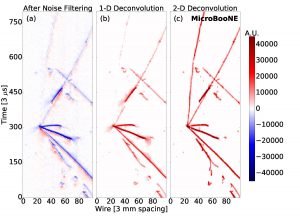Professor Mike Mooney’s group has recently published papers two papers, “Ionization Electron Signal Processing in Single Phase LArTPCs I. Algorithm Description and Quantitative Evaluation with MicroBooNE Simulation” and “Ionization Electron Signal Processing in Single Phase LArTPCs II. Data/Simulation Comparison and Performance in MicroBooNE.”
MicroBooNE (Micro Booster Neutrino Experiment) is a neutrino experiment located at Fermilab in Batavia, Illinois, which makes use of the liquid argon trim projection chambers (LArTPCs) technology to study neutrinos. LArTPCs are imaging particle detectors that can be used to identify and study fundamental particles, such as neutrinos. One potential outcome of the experiment is the discovery of a new particle, a so-called “sterile neutrino” that does not interact with matter in the way that other neutrinos do. The MicroBooNE LArTPC effectively functions as an 80 megapixel camera, producing images as its raw data that can be used to find and characterize particles produced from neutrinos interacting in the argon. The work presented in these two papers centers around the development of novel signal processing techniques to produce “crisper” images; the improved image quality allows one to more effectively find and study these neutrino interactions, increasing the physics reach of LArTPC experiments such as MicroBooNE. The Colorado State University researchers involved in this work are Prof. Mike Mooney and graduate student Ivan Caro Terrazas.

